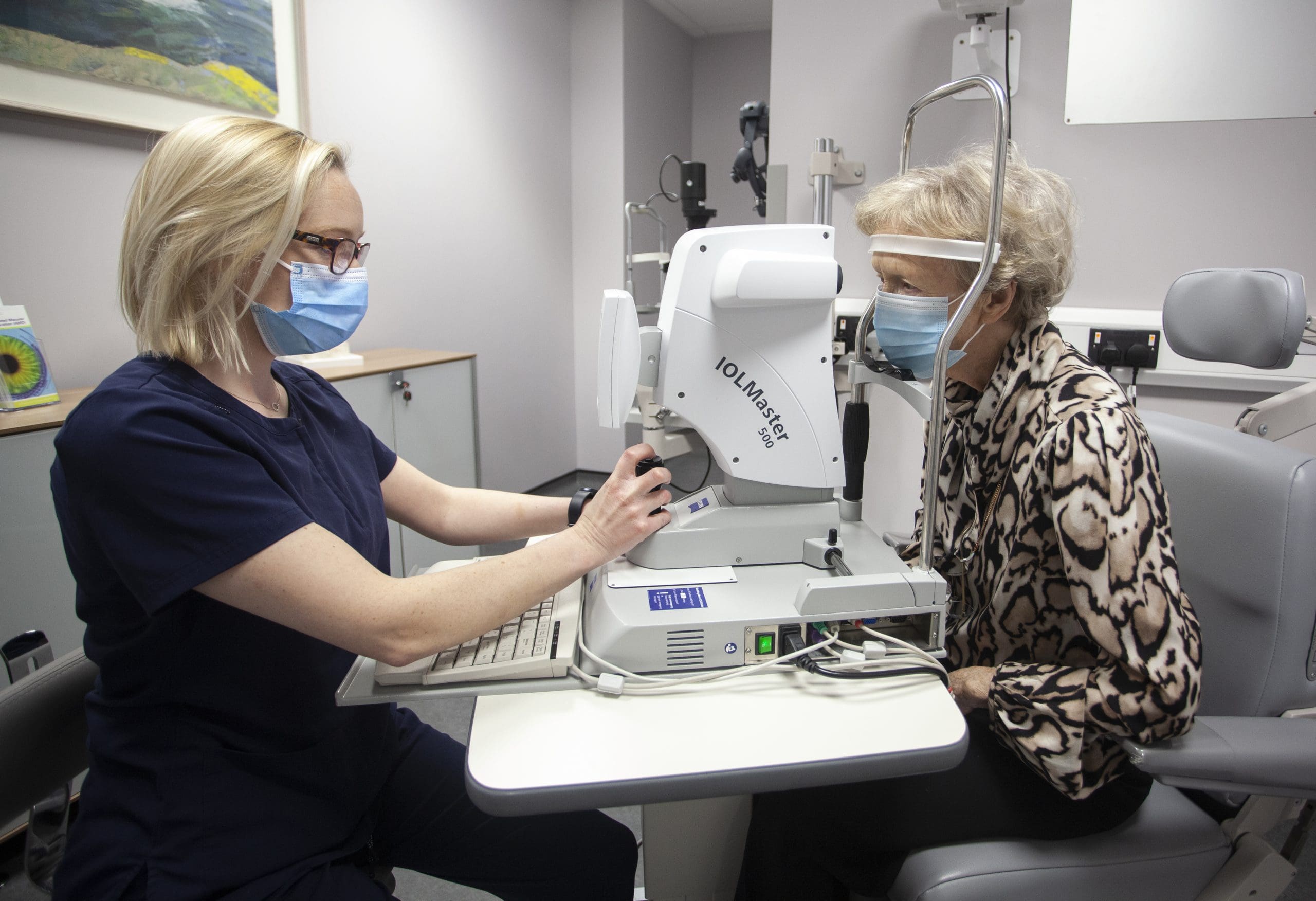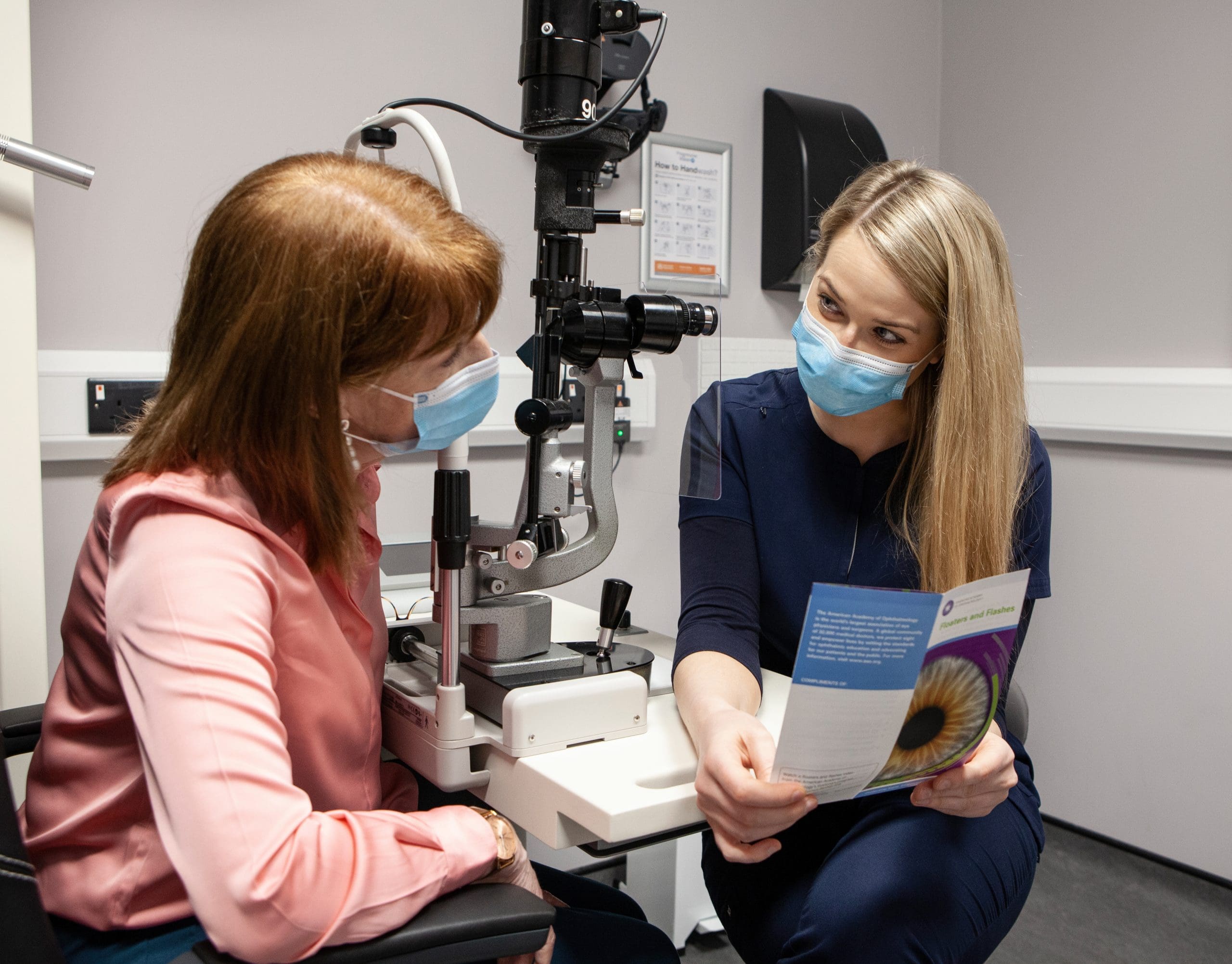A chronic, degenerative condition affecting central vision.
What is a cataract?
Inside our eyes, we have a natural lens. This has a core that sits in a natural bag, the capsule. The lens focuses light rays that come into the eye on to the retina at the back of the eye to help us see. This lens should be clear.
What is a cataract?
A cataract is when your eye’s natural lens core becomes cloudy. This happens as we get older as the natural proteins in the lens continue to form throughout our lives but become more compacted in the core. This can cause your vision to become blurred and hazy.
Cataract Symptoms
- Your eyesight is blurred or misty
- Ghost images or double vision
- Being extra sensitive to light (especially with oncoming headlights at night)
- Having trouble seeing well at night, or needing more light when you read
- Seeing bright colours as faded or yellow instead
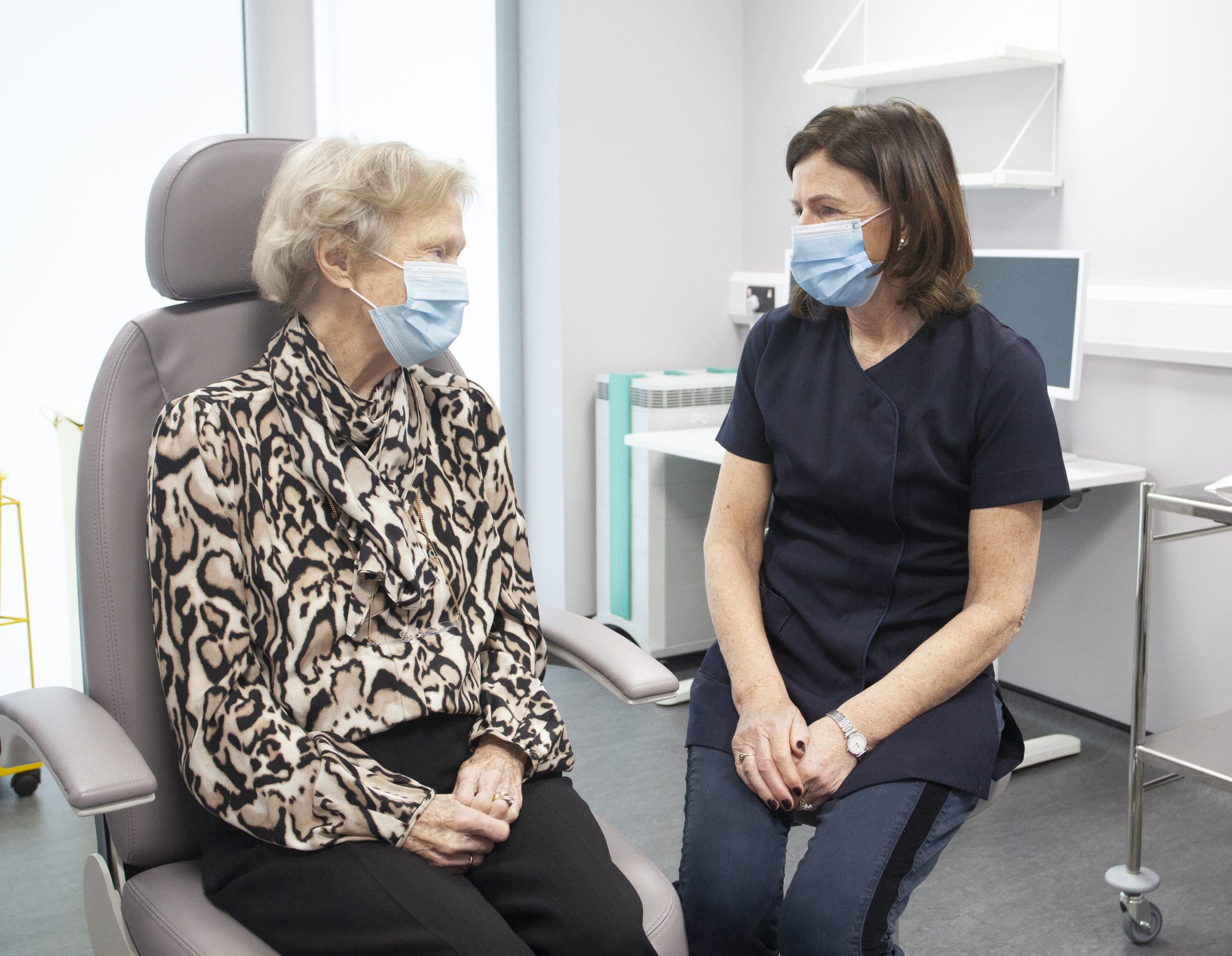
What Causes Cataracts?
Getting older is the most common cause. This is due to normal eye changes that begin to happen after age 30. People over age 60 usually start to have some clouding of their lenses. However, vision problems may not happen until years later.
Other reasons you may get cataracts include:
- having parents, brothers, sisters, or other family members who have cataracts
- having certain medical problems, such as diabetes
- smoking
- having had an eye injury, eye surgery, or radiation treatments on your upper body
- having spent a lot of time in the sun, especially without sunglasses that protect your eyes from damaging ultraviolet (UV) rays
- using certain medications such as corticosteroids, which may cause early formation of cataracts.
Most age-related cataracts develop gradually. Other cataracts can develop more quickly, such as those in younger people or those in people with diabetes. Eye doctors and Optometrists can’t predict how quickly a person’s cataract will develop.
Cataract Treatment
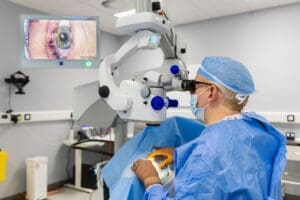
Surgery is the only option for cataract removal.
If your cataract symptoms are not bothering you very much, you don’t have to remove a cataract. You might just need a new eyeglass prescription to help you see better. You should consider surgery when cataracts keep you from doing things you want or need to do.
video from ww.aao.org
How does cataract surgery work?
- During cataract surgery, your eye surgeon will remove your eye’s cloudy natural lens core leaving the bag, or capsule behind. Then he or she will replace the core with an artificial lens which sits in the original natural bag. This new lens is called an intraocular lens (or IOL). When you decide to have cataract surgery, your eye doctor or Optometrist will talk with you about IOLs and how they work.
- People who have had cataract surgery may have their vision become hazy again years later. This is usually because the natural lens bag or capsule has become cloudy. This because the IOL causes a biofilm to form on the capsule. The capsule is holding the IOL in place. Your eye doctor can use a laser focused through your pupil to make an opening in the cloudy capsule and restore clear vision. This is called a YAG capsulotomy
- Cataracts are a very common reason people lose vision, but they can be treated. You and your eye doctor or optometrist should discuss your cataract symptoms. Together you can decide whether you are ready for cataract surgery.

OBS:
Office-based surgery involves surgical or invasive procedures performed by a doctor in their office instead of a hospital, using a surgical suite and typically minimal sedation.

SAFETY:
Progressive Vision provides hospital-quality care in a more comfortable environment, adhering to strict safety, staff, and equipment standards.
Our office-based surgery suite, designed specifically for eye surgeries, meets or exceeds hospital safety standards and is fully accredited.
Research on over 93,000 cases shows that outcomes from such suites are comparable to or better than those in hospitals.

ADVANTAGES:
By combining clinic and surgery in one location, we provide personalised, efficient care with the same trusted team, offering a more comforting experience compared to a traditional hospital.

NO FASTING OR IV REQUIRED:
Office-based cataract surgery does not require fasting or IV sedation, unlike hospital procedures. Instead, oral or local anaesthesia is used, providing a more comfortable and less stressful experience, particularly for those who find fasting challenging.
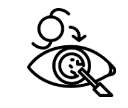
NEWER EQUIPMENT:
Our office-based surgery centre specialises in eye surgeries, using newer and more advanced equipment compared to hospitals where tools are used for a variety of procedures. This ensures your cataract surgery is performed with the latest, most precise tools.

CONVENIENT LOCATION:
Driving to a hospital can be stressful, especially if it is far from home.
Our office-based cataract surgery centre is located in Swords, Co. Dublin in a smaller, easy-to-access building.
This makes it more convenient for you and your loved ones to travel to the surgery, especially when you need someone to drive you home afterwards.

REDUCED WAIT TIMES:
Office-based centres, focused on eye surgeries, offer shorter wait times compared to hospitals, allowing you to schedule your surgery sooner and begin recovery faster.

EYE FOCUSED:
Our office-based surgery centre focuses exclusively on eye procedures, with specialised staff and equipment. The team, who are highly trained in ophthalmology, perform eye surgeries and other eye procedures daily, ensuring expert care for your eye health.
SURGERY DAY CHECKLIST

To ensure a smooth and stress-free experience, follow these steps on the day of your surgery:
• Travel arrangements: Ask a family member or friend to drive you to and from the clinic.
• Dress comfortably: Wear loose-fitting clothing.
• Check-in: Review the procedure details with our staff.
• Pre-Surgery Preparation: Our team will get you ready for surgery.
• The Procedure: Your cataract surgery will take 15 to 30 minutes.
• Post-Surgery Instructions: We’ll provide clear guidelines on how to care for your eye.
• Post-Surgery Recovery: When you feel ready, your companion can take you home.
• Most patients spend 90 minutes to 2 hours in the clinic from start to finish, making the process quick and convenient while providing you with the best possible care.
Office-Based Cataract Surgery at Progressive Vision Swords - frequently asked questions
Cataract surgery at Progressive Vision is covered by major Health Insurers (Procedure code 2802).
For self-paying patients, the cost of surgery with a monofocal lens is €2,500 per eye.
ASCAN costs €100
Post Operative Review- cost ranges from €120 to €200
Please call our office if you need further information on 01 2135652
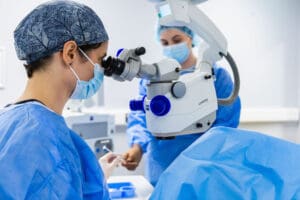 Plan for two hours. We focus on ophthalmic procedures, allowing for shorter surgery times compared to typical day-case centres.
Plan for two hours. We focus on ophthalmic procedures, allowing for shorter surgery times compared to typical day-case centres.
No, you do not need to fast.
No, you will need a friend or family member to drive you home after surgery.
In most cases, you can continue your usual medications. Your doctor will advise you before surgery.
Cataract surgery in hospital
You will be in the hospital for approximately 4 to 5 hours altogether. The surgery itself takes 25 to 30 minutes.
No. A gown will be provided for your time in theatre. Otherwise, dress comfortably.
Yes, you need to fast for 6 hours before your appointment time. If your appointment time is before 12.00 Midday you need to fast from 12.00 Midnight. This is in case you need a general anaesthetic. If you take any important medication, take it with a small sip of water. We do not want to interfere with important medications for your blood pressure, diabetes or other health conditions.
Topical anaesthetic:
Most people are awake but sedated for the surgery. You will be given drops to numb the eye and sedation into a vein in your hand or arm to help with any anxiety you have. During the operation an eyelid speculum will also be used to keep the eye open. You will see a bright light that changes colour and you will feel cool water on your eye.
If you are nervous on the day and think you want a general anaesthetic, you can discuss this with your eye doctor prior to surgery. Some people find the theatre light to be very bright and are unable to tolerate it. If this is the case, your eye doctor could decide to give you a general anaesthetic.
General anaesthetic:
If you decide you do not want to be aware of anything happening during the surgery will be need to have a general anaesthetic. This does not mean that you will have to stay overnight in the hospital but you may be in the hospital for an extra hour or so.
You will need someone to bring you and collect you from the hospital. The day ward nursing staff will phone that person for you when you are nearly ready to go. It is nice to have somebody to take you home and help you settle in.
Post-operative instructions for cataract surgery
Keep the eye shield on the eye for the first day then only at night-time for the first week. If you have a double pad and a shield, remove the pad at 6pm that evening but keep the shield on that night and then only at night for the first week.
- You will be given a prescription for the post-operative steroid drops and are asked to put a drop in at 6pm and 10pm on the evening of surgery. These drops are usually used four times a day for the first week and then reduced by one drop per day each week for the next three weeks (i.e. 4 drops a day first week, 3 drops a day second week, 2 drops a day third week, 1 drop a day fourth week). The Prescription also includes an antibiotic drop which is usually used four times a day for one week only
- You can experience blurred vision or a gritty sensation in the eye for the first few days after surgery.
Do
- Wash your hands thoroughly before cleaning the eye or applying your eye drops.
- If necessary, clean around the eye with previously boiled water that has been allowed to cool.
- Apply all drops and /or ointments as prescribed by Mark.
- Wear dark glasses if you feel your eyes are sensitive to light
- Wear the shield continuously if you feel you are rubbing your eye.
- Take life easy, taking particular care going up and down stairs
- Attend your post operative clinic appointment.
- Call if you have any problems or pain
Do not
- Get water into your eye for the first day.
- Rub the eye under any circumstances.
- Stoop, bend or heavy lifting for one week.
- Undertake work or sports until advised by your eye doctor.
- We will ensure you get your post-operative instructions on the day of surgery.
- It is important to try to avoid any bending, stooping or heavy lifting for 10 to 14 days after surgery.
- Golf or cycling should be avoided for 2 weeks and swimming should be avoided for 4 to 6 weeks (due to risk of infection).
- The post-operative review is generally 2 to 4 weeks after surgery, by that stage we normally give you the all-clear to return to most normal activities.
You should not drive on the day of your surgery, or the next day. But the eye should be settled by the second day following surgery. You should only return to driving if you are comfortable.
The eye should be fully settled before you return to your optometrist to update your glasses. We usually recommend waiting until 2 weeks after you have stopped your drops.
If one eye only has been done, you can ask your optometrist/optician to remove the lens from the eye that has been done and replace it with a clear lens, until both eyes have been done.
Request an Appointment / Further Information
Please fill out the information below and we will contact you to discuss the best possible time for an appointment or for a general enquiry.
"*" indicates required fields
